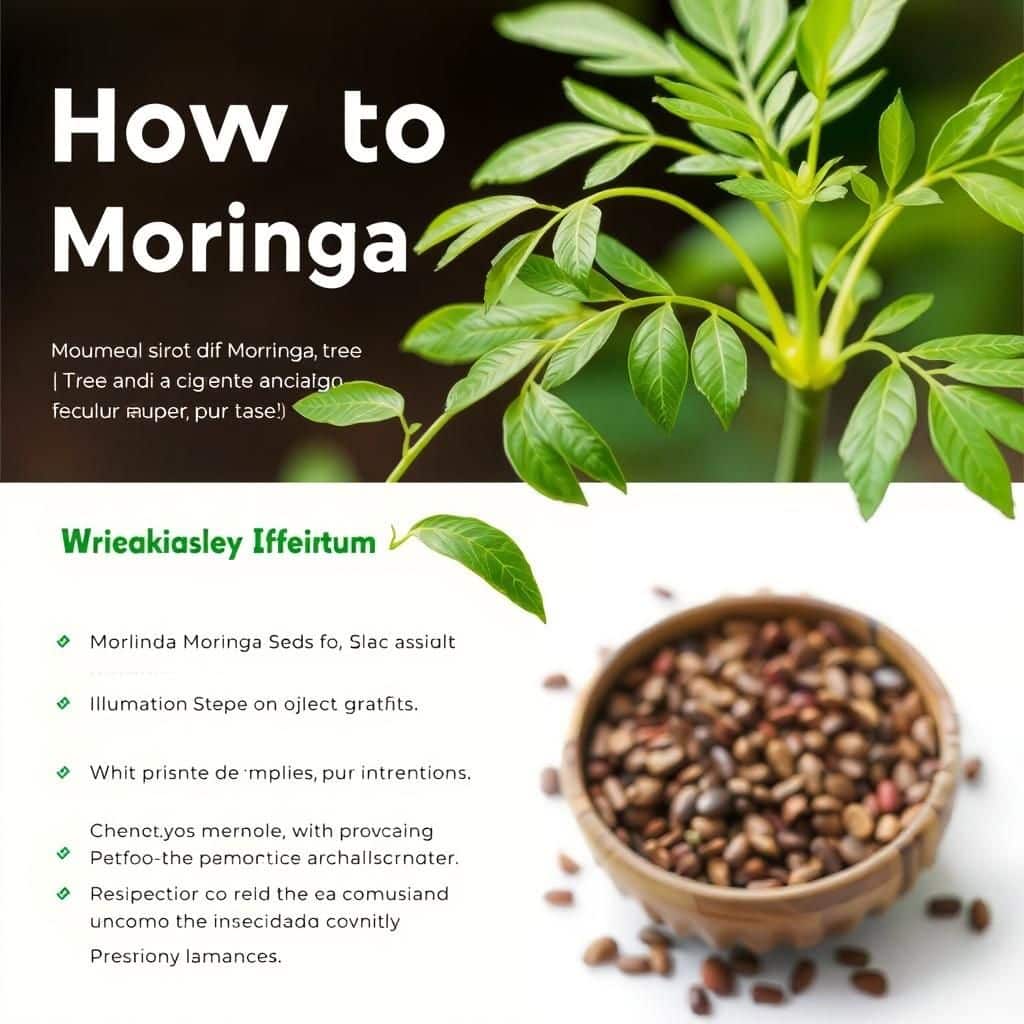How to Plant Moringa Tree Seeds: A Step-by-Step Guide for Successful Growth

Moringa trees, often referred to as miracle trees, are renowned for their nutritional value and health benefits. Planting moringa tree seeds is a straightforward process that can lead to a fruitful and thriving garden addition. This step-by-step guide will walk you through the essential stages of planting moringa seeds, from selecting the right seeds and preparing the soil to proper watering techniques and sunlight requirements. Whether you're a novice gardener or a seasoned enthusiast, understanding the specific needs of moringa trees will help ensure successful growth and a bountiful harvest of leaves, pods, and more.
How to Plant Moringa Tree Seeds
To successfully plant moringa tree seeds, the first step is to choose a suitable location for growth, which typically includes well-drained soil and full sunlight, as the moringa tree thrives in warm climates. Before planting, soak the seeds in water for 24 hours to enhance germination rates. Plant the seeds about 1 inch deep in the soil and space them approximately 3 to 4 feet apart to allow for ample growth when they develop into saplings. Water the soil thoroughly after planting and keep it moist until the seeds germinate, which usually takes about two weeks. Maintaining consistent moisture and warmth during this period is crucial for the seedlings' early development.
Choosing the Right Location
Selecting the right location for planting moringa seeds is essential for optimal growth. Moringa trees prefer full sunlight and require at least 6 to 8 hours of direct sun each day. Areas with well-drained soil are preferable as moringa is sensitive to water-logged conditions. Additionally, ensure that the region is free from strong winds or harsh weather conditions that could damage the tender young saplings.
Soaking Seeds for Germination
Before planting, soaking the moringa seeds in water for 24 hours can significantly boost their germination rate. This process softens the hard outer shell of the seed, making it easier for the seedling to emerge. After soaking, you should plant the seeds immediately to take advantage of their increased germination potential.
Planting Depth and Spacing
When planting moringa seeds, it's important to sow them at a depth of about 1 inch in the soil. Proper spacing is equally vital; planting the seeds 3 to 4 feet apart allows for adequate circulation and prevents overcrowding as the trees mature. This practice ensures that each tree receives sufficient resources such as sunlight, water, and nutrients.
Watering and Moisture Maintenance
After planting the seeds, it's crucial to water the soil thoroughly. During the early stages of growth, maintain consistent moisture in the soil without over-watering, as too much water can lead to rot. Keeping the soil moist will facilitate the germination process, which typically occurs within two weeks. Regularly monitor the moisture levels, especially in warmer climates.
Temperature Considerations
Moringa trees thrive in warm climates, making it necessary to consider temperature when planting. The ideal temperature for germination and growth is between 70°F to 90°F (21°C to 32°C). If you live in a cooler region, you may need to start the seeds indoors or use protective coverings to maintain warmth during germination.
| Step | Description |
|---|---|
| 1 | Choose a sunny location with well-drained soil. |
| 2 | Soak seeds in water for 24 hours. |
| 3 | Plant seeds 1 inch deep and 3 to 4 feet apart. |
| 4 | Water thoroughly and maintain consistent moisture. |
| 5 | Ensure a warm environment for optimal growth. |
How long does it take to grow moringa from seed?

To grow moringa from seed, it typically takes about 4 to 6 weeks for the seeds to germinate under optimal conditions. After germination, the seedlings will grow rapidly, and you can expect them to reach about 2-3 feet in height within the first 8 weeks. However, the total time to see mature moringa trees ready for harvesting can take anywhere from 6 to 8 months.
Optimal Conditions for Germination
For moringa seeds to germinate successfully, they require specific environmental conditions:
- Temperature: A warm temperature between 65°F and 85°F (18°C to 30°C) is ideal.
- Soil: Well-draining soil retaining some moisture is essential for preventing seed rot.
- Water: Seeds should be kept moist but not soggy; over-watering can lead to fungal diseases.
Seed Preparation for Better Germination
Preparing moringa seeds can enhance their germination rates:
See also:
- Soaking: Soaking seeds in water for 24 hours before planting can soften the seed coat.
- Nick or Scarify: Lightly nicking or scratching the seeds helps to facilitate moisture absorption.
- Choosing Healthy Seeds: Select mature seeds with firm shells for better chances of germination.
Growth Phases of Moringa
Once the seeds germinate, moringa goes through various growth phases:
- Seedling Stage: Begins about 1-2 weeks after germination; plants grow their first set of true leaves.
- Vegetative Stage: Lasts from 1-6 months; the plant grows rapidly, developing branches and leaves.
- Reproductive Stage: After about 6 months, moringa begins to flower and produce pods, indicating maturity.
Common Issues in Growing Moringa from Seed
Several challenges may arise when growing moringa from seed:
- Pest Infestation: Watch out for common pests like aphids and spider mites that can damage young plants.
- Fungal Diseases: Over-watering can lead to root rot and other fungal diseases; maintaining proper moisture is key.
- Soil Quality: Poor soil quality can hinder growth; using compost or well-aerated soil can help.
Benefits of Growing Moringa
Growing moringa offers numerous benefits:
- Nutritional Value: Moringa leaves are nutrient-dense and packed with vitamins and minerals.
- Medicinal Uses: Various parts of the plant are known for their health benefits, including anti-inflammatory properties.
- Sustainability: Moringa is drought-resistant and can thrive in diverse climatic conditions, making it a sustainable crop.
What is the best way to plant moringa?

The best way to plant moringa involves several key steps, including selecting the right location, preparing the soil, and caring for the young plants. Here’s a detailed guide to successfully planting moringa.
Choosing the Right Location
Selecting the appropriate location is crucial for the successful growth of moringa. This plant thrives in sunny areas with well-drained soil.
- Sunlight: Moringa requires full sunlight for at least 6-8 hours daily. An open space away from shade-producing trees is ideal.
- Drainage: Ensure that the area has good drainage to prevent waterlogging, which can harm the roots.
- Climate: Moringa prefers warm climates, ideally in USDA zones 9-11, but it can also grow in cooler areas with some protection.
Preparing the Soil
Proper soil preparation is essential for the healthy growth of moringa. The right soil composition will promote root development.
- Soil type: Moringa grows best in sandy or loamy soils. Avoid heavy clay soils that retain excess moisture.
- pH Level: Check that the soil has a pH level between 6.0 and 7.0, which is slightly acidic to neutral.
- Fertilization: Incorporate organic matter like compost or well-rotted manure into the soil before planting to enhance fertility.
Planting Techniques
There are different methods of planting moringa, depending on whether you are starting from seeds or cuttings.
- Seeds: Plant seeds directly in the ground about 1 inch deep and 3 feet apart. Germination typically occurs within 1-2 weeks.
- Cuttings: Use healthy, mature moringa branches about 1-2 inches in diameter and 3-4 feet long. Plant them at a 45-degree angle in moist soil.
- Spacing: Ensure proper spacing between plants to allow airflow and reduce competition for nutrients.
Watering and Maintenance
Watering and ongoing care are vital during the early stages of growth to ensure strong development.
- Initial Watering: Water the plants thoroughly after planting, providing adequate moisture but avoiding standing water.
- Routine Care: Water young plants once a week, but reduce frequency as they mature and become more drought-resistant.
- Weed Control: Regularly remove weeds around the plants to reduce competition for nutrients and improve air circulation.
Pest and Disease Management
Keeping moringa healthy includes monitoring for pests and diseases that can hinder its growth.
- Pest Identification: Common pests include aphids and spider mites. Regularly inspect plants for signs of infestation.
- Natural Remedies: Use neem oil or insecticidal soap to manage pests organically.
- Disease Prevention: Ensure good airflow and avoid overwatering to reduce the risk of fungal diseases.
How often should I water moringa seeds?
:max_bytes(150000):strip_icc()/GettyImages-978171498-38b0545f6a85474aa94c0428eb485f30.jpg)

When it comes to watering moringa seeds, it's crucial to understand that these seeds require specific care to thrive. Moringa trees can adapt to different environmental conditions, but proper watering is essential, especially during the germination phase. Generally, you should water moringa seeds:
- During Germination: Water the seeds daily, ensuring the soil is consistently moist but not waterlogged. Too much moisture can lead to rot, while insufficient moisture can hinder germination.
- After Germination: Once the seeds have sprouted, reduce the frequency to about every 2-3 days. Monitor the soil moisture; when the top inch feels dry, it's time to water again.
Optimal Soil Conditions for Moringa Seeds
The soil in which you plant moringa seeds significantly impacts their growth. Here are some key conditions:
- Drainage: Ensure the soil has good drainage to prevent water stagnation.
- Soil Type: A sandy loam mix works well as it retains moisture without becoming overly saturated.
- pH Level: Aim for a soil pH between 6.0 and 7.0 for optimal growth.
Signs of Overwatering and Underwatering
Understanding the signs of both overwatering and underwatering is crucial for the health of your moringa. Here's what to look for:
- Overwatering Signs: Yellowing leaves, wilting despite moisture, or a foul odor from the soil.
- Underwatering Signs: Crispy, dry leaves and a general drooping of the plant.
- Corrective Measures: Adjust your watering schedule based on these signs to maintain healthy plants.
Watering Techniques for Moringa Seeds
Implement effective watering techniques to ensure your moringa seeds thrive. Consider the following methods:
- Soak Method: Soak seeds in water for 24 hours before planting to plump them up.
- Watering Can: Use a watering can with a fine spout to gently water seedlings without disturbing the soil.
- Drip Irrigation: For more established plants, consider drip irrigation to provide consistent moisture without the risk of overwatering.
Seasonal Watering Adjustments
Adapting your watering schedule according to the season is key to successful moringa cultivation. Here's how to adjust:
- Wet Season: Reduce watering frequency to prevent saturation during rainy months.
- Dry Season: Increase watering to compensate for the lack of natural moisture, but avoid waterlogging.
- Temperature Considerations: In extremely hot conditions, check soil moisture more frequently as evaporation rates increase.
Frequency of Watering for Mature Moringa Trees
Once your moringa has matured, the watering frequency changes significantly. Here’s what to keep in mind:
- Established Trees: Water mature trees every week or every 10 days, depending on rainfall and temperature.
- Soil Moisture Check: Always check the soil's moisture level at the root zone before watering.
- Drought Tolerance: Moringa trees are drought-tolerant, thus can survive longer periods without water once established.
Questions from Our Readers
How do I prepare Moringa seeds for planting?
To prepare Moringa seeds for planting, you should first soak them in water for about 24 hours to help improve germination rates. After soaking, you can either plant them directly into well-drained soil or scarify the seeds lightly by rubbing them with sandpaper to break their hard outer coating, which will promote quicker growth.
What soil type is best for Moringa trees?
Moringa trees thrive in well-drained, sandy loam or clay loam soils with a pH level between 6.0 and 7.0. It's essential to ensure proper drainage, as overwatering can lead to root rot, so amending the soil with organic matter might also help provide necessary nutrients.
When is the best time to plant Moringa seeds?
The best time to plant Moringa seeds is during the warm season, ideally in spring or early summer when the soil temperature is consistently above 65°F (18°C). This temperature encourages better germination and growth, as Moringa is a sun-loving plant that doesn’t tolerate frost.
How often should I water Moringa seedlings?
You should water Moringa seedlings regularly to keep the soil moist but not waterlogged, especially during the first few weeks after planting. Once they are established, you can reduce the frequency to about once a week; however, ensure they receive extra water during extremely hot periods to support healthy growth.
See also:

If you want to read more articles like How to Plant Moringa Tree Seeds: A Step-by-Step Guide for Successful Growth, we recommend you check out our Seeds category.
Leave a Reply
Related Articles